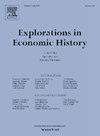第二次世界大战军队服役对20世纪60年代少数民族收入和流动性的影响
IF 1.7
1区 历史学
Q1 ECONOMICS
引用次数: 0
摘要
我们将1940年的全面人口普查与二战入伍记录和1969年的行政纳税申报表联系起来,研究二战期间在陆军和陆军空军服役如何影响1969年非西班牙裔白人、黑人、西班牙裔、亚裔和美洲原住民男性陆军退伍军人的收入和流动性。我们的数据集的规模提供了足够的力量来揭示以前未被充分研究的群体,如西班牙裔,亚洲人和美洲原住民。在陆军退伍军人与非陆军退伍军人的比较中,普通最小二乘估计表明,在同一组中,二战陆军退伍军人的收入高于非陆军男性,并且在1940年至1969年期间,陆军退伍军人比非西班牙裔白人、黑人和西班牙裔群体中的非陆军男性更不可能改变县。对选择偏差的担忧使我们用模糊回归不连续设计来估计影响,该设计将二战期间年龄太小而不能服役的男性与年龄刚好可以服役的男性进行比较。这些结果表明,在非西班牙裔白人、黑人和亚裔群体中,陆军退伍军人的调整后总收入低于非军队男性,而在西班牙裔和美洲原住民群体中,退伍军人的收入略高。这种差异因收入类型而异。在非西班牙裔白人、亚洲人和印第安人中,陆军退伍军人的跨县迁移率低于非军队男性,黑人和西班牙裔之间的差异很小。本文章由计算机程序翻译,如有差异,请以英文原文为准。
The impact of World War II Army service on income and mobility in the 1960s by ethnoracial group
We link the 1940 full-count Census to World War II enlistment records and 1969 administrative tax returns to study how WWII service in the Army and Army Airforce impacted the income and mobility of non-Hispanic White, Black, Hispanic, Asian, and Native American male Army veterans relative to their non-Army counterparts in 1969. The size of our data set provides enough power to shed new light on previously understudied groups, such as Hispanics, Asians, and Native Americans. In comparisons of Army veterans with non-Army men, Ordinary Least Squares estimates suggest that WWII Army veterans had higher incomes than non-Army men within the same group, and Army veterans were less likely to change counties between 1940 and 1969 than non-Army men within the non-Hispanic White, Black, and Hispanic groups. Worries about selection bias led us to estimate the effects with a fuzzy regression discontinuity design that compares men who were just too young to serve during World War II to men who were just old enough to serve. Those results showed that Army veterans had lower adjusted gross incomes than non-Army men within the non-Hispanic White, Black, and Asian groups, and slightly higher incomes within the Hispanic and Native American groups. The differences varied by type of income. Migration across county boundaries was lower for Army veterans than non-Army men among non-Hispanic Whites, Asians, and Native Americans, and there were only small differences among Blacks and Hispanics.
求助全文
通过发布文献求助,成功后即可免费获取论文全文。
去求助
来源期刊

Explorations in Economic History
Multiple-
CiteScore
2.50
自引率
8.70%
发文量
27
期刊介绍:
Explorations in Economic History provides broad coverage of the application of economic analysis to historical episodes. The journal has a tradition of innovative applications of theory and quantitative techniques, and it explores all aspects of economic change, all historical periods, all geographical locations, and all political and social systems. The journal includes papers by economists, economic historians, demographers, geographers, and sociologists. Explorations in Economic History is the only journal where you will find "Essays in Exploration." This unique department alerts economic historians to the potential in a new area of research, surveying the recent literature and then identifying the most promising issues to pursue.
 求助内容:
求助内容: 应助结果提醒方式:
应助结果提醒方式:


